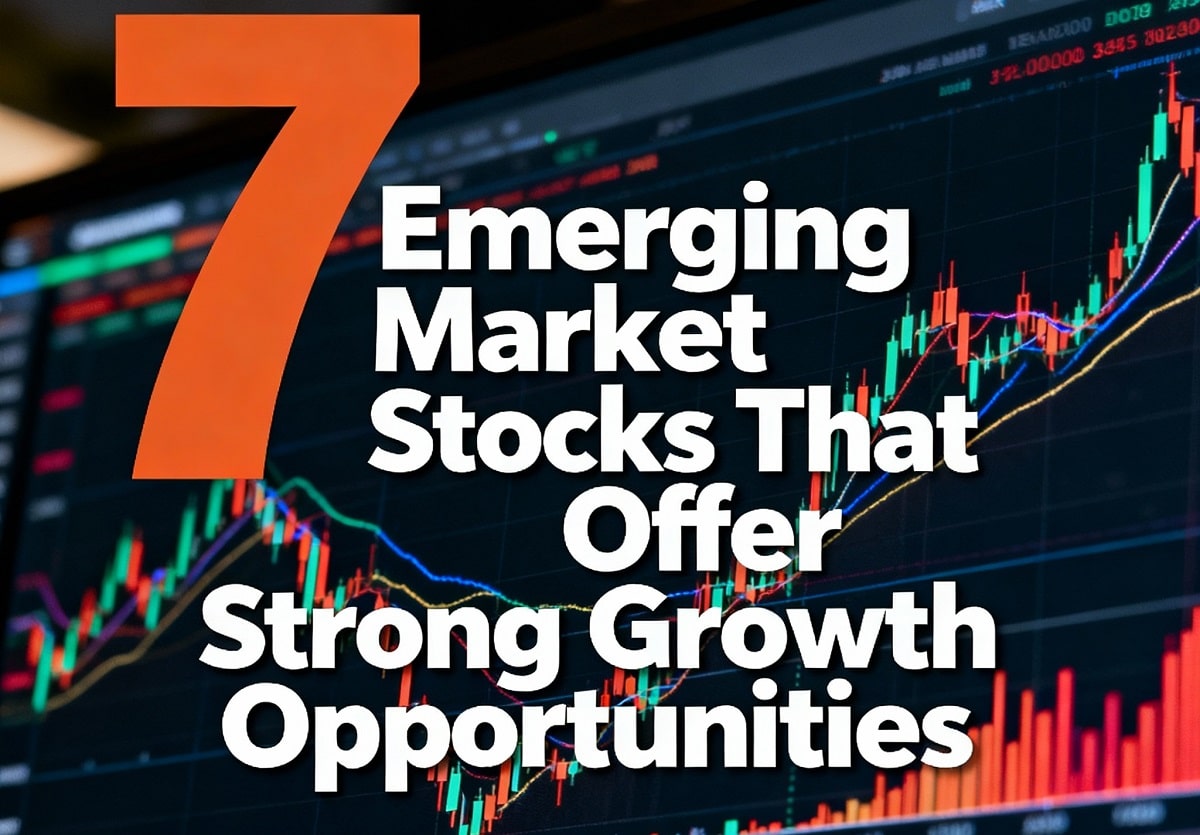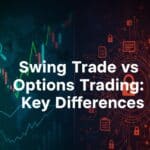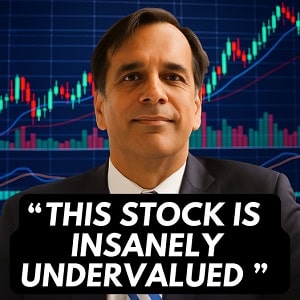Have you ever sat across the table with someone who swears they missed the “next big thing” in stocks—only to discover it was happening halfway around the world? I have. And I learned something very quickly: while everyone else is chasing the same U.S. giants, some of the best opportunities live outside the headlines—in the global emerging markets.
You’ll hear “emerging markets” and think “junk risk,” “political chaos,” or “currency nightmare.” Fair enough. But here’s a surprising fact: many emerging-market companies are now among the most innovative, fastest-growing firms on earth. They’re not just catching up—they’re leap-frogging. And if you know where to look, you can tap into growth that has both scale and runway.
So here’s the deal: I’m going to walk you—my fellow trader/investor—through seven real publicly-traded emerging-market stocks (names + tickers) that I believe are positioned for strong growth. We’ll dig into what makes them interesting, what risks you must accept, and why now is the moment to take action.
You might ask: “Who is this guy telling me this?” Good question. I’ve spent the last decade managing a mix of global equity portfolios, running my own small trading account, and doing deep dives into emerging markets when most were turning away. I missed some big hits—for example, one Brazilian fintech where I got in too early and lost patience. But I also discovered a handful of companies in India, Southeast Asia, and Latin America that turned into multi-baggers (at least compared with U.S. large-cap averages).
I’m not presenting this as a miracle recipe. I’m presenting this as what I’ve seen work. I’ve watched emerging-market valuations get punished, currencies blow up, and still seen companies walk away with stronger businesses doing larger revenues years later. And I’ve seen companies get hyped and then collapse because they ignored fundamentals. I learned to combine the structural growth story with disciplined risk controls—and that’s what I’ll show you in this article.
Growth Is Where Emerging Markets Win
When you look for outsized returns, you look for companies that can grow revenues, earnings, or user bases at double the rate of the broader market. Emerging markets still have that advantage. A few things combining in their favor: young populations, rising middle classes, digitization happening faster (because they skip legacy systems), and large addressable markets that Western companies have already saturated.
Let’s take a concrete example. One of the companies I have on my radar is from Latin America—one of the regions less covered in the U.S. but packed with digitization potential. (I’ll identify the exact name and ticker later in the full list.) The point is that its payment-volume growth in the last year was >40 %. Meanwhile, many U.S. peers are growing mid-teens at best in a matured market.
Another example: in Asia, chip fabrication and semiconductors are dominated by companies based in Taiwan and South Korea—emerging-market economies in global terms, yet playing a global role. One of those companies is seeing its advanced-chip output demanded not just by local markets but by the world’s largest AI players.
Here’s what to look for when judging growth in an emerging-market stock:
-
Revenue growth of 20 %+ year over year — ideally accelerated, not slowing.
-
User or customer base growth — not just sales to existing customers.
-
Margin improvement or stable margins — growth without margin decline is gold.
-
Addressable market size — is there “room to grow,” or is the company already saturated?
If you find a company that checks most of those, you’re already ahead of where many investors are. Combine that with top-tier execution, and you’ve got a real opportunity.
Dominant Regional Players Can Outperform
In emerging markets, the companies that win often aren’t global giants—they’re regional champions. They dominate local markets, benefit from regulatory or structural advantages, and then export that dominance outward. These firms are different from global behemoths in that they know the terrain, the consumers, and operate in environments where big global competitors often struggle.
For example, in Latin America or Southeast Asia you’ll find fintech or e-commerce companies that look, to local consumers, like “the Amazon” or “the PayPal” of the region—but they may not yet exist in the U.S. spotlight. One such company grew its total payments volume by a striking percentage year-on-year because it captured both the logistics and payment side of e-commerce in a region with low penetration.
In India, you have firms that have built enormous digital ecosystems from scratch rather than being constrained by legacy infrastructure. Banks, consumer-tech platforms, digital payments—they’re all still scaling.
And in regions such as Africa, you have mobile-based financial services companies leapfrogging decades of legacy banking infrastructure. One large African telecom/fintech firm now counts hundreds of millions of users, expanding revenue in fintech much faster than its core telecom business.
The takeaway: when you invest in emerging-market growth, look for local dominance + structural tailwind. That combination often beats “global follower” companies.
Risk Is Real—but Manageable
Here’s where many investors hesitate: political risk, currency risk, regulatory risk, market opacity. They’re all valid. I’ll be blunt: you’re not in Kansas anymore when you invest in the budding markets of the world. But you can manage it—and if you do, the reward can be superior.
From my experience, the largest emerging-market risks that get overlooked are:
-
Currency depreciation: If the local currency tanks, your returns can evaporate in dollar terms.
-
Regulatory shock: Governments can intervene—especially where tech or fintech is involved.
-
Corporate governance and transparency: Some firms don’t have the same level of disclosure as U.S. companies.
-
Liquidity & foreign-investor sentiment: If global risk aversion spikes, capital flows out fast.
So what do I do to manage it?
-
I limit any single emerging-market position to a size I’m comfortable with (e.g., no more than 3–5 % of my equity portfolio).
-
I pick companies listed on exchanges with decent regulatory standards (even if headquartered in higher-risk countries).
-
I watch currency trends and hedge or accept the risk consciously.
-
I use valuation discipline: even a great structural story is no bargain if you pay too much.
In the sections ahead, you’ll see each stock pick isn’t a blind “emerging market bet” — it’s a business with a clear path, tangible metrics, and risk-mitigation built in.
We’ve set the stage: you’re ready for growth, you understand regional winners matter, and you’re aware of the risk backdrop. Next, I’ll dive into the seven specific emerging-market stocks (names and tickers) I’ve identified—with why they stand out, what metrics I’m watching, and how they might fit your portfolio.
7 Emerging Market Stocks That Offer Strong Growth
Here are the names, tickers, and the stories behind them.
1) Taiwan Semiconductor Manufacturing Company (Ticker: TSM)
-
Why I like it: TSM is a foundational player in the global semiconductor ecosystem. Emerging and growth-markets logic applies beautifully here: despite being headquartered in Taiwan, it serves global tech demand, giving you emerging-market upside with global structural tailwinds. According to recent listings, TSMC has ~67% global foundry share and is ramping massive capital expenditures to stay ahead of rivals.
-
What to watch: Keep an eye on manufacturing lead times, cap-ex announcements, and geopolitical tension (Taiwan / China). Also check gross margin trends and foundry utilisation.
-
Fit for your portfolio: If you believe AI, computing, and chips continue to boom, TSM gives emerging-market leverage without being a small speculative startup.
2) MercadoLibre, Inc. (Ticker: MELI)
-
Why I like it: Latin America’s leading e-commerce + fintech platform. Emerging-markets consumers are digitising rapidly and MELI sits at the intersection of retail growth and digital payments adoption. From Saxo Bank’s breakdown, MercadoLibre delivered 36% year-on-year net revenue growth and a 46% increase in total payment volume.
-
What to watch: Macroeconomic risks in Brazil/LatAm, currency impact, regulatory changes on fintech, and competition.
-
Fit: If you want direct exposure to consumer digital leapfrog in less-covered regions, this is a strong candidate.
3) Alibaba Group Holding Limited (Ticker: BABA)
-
Why I like it: One of China’s largest tech/consumer platforms. With cloud, e-commerce, logistics, payments — it’s a structural play on China’s consumer upgrade & tech transition. According to a high-growth emerging-market stock list, Alibaba remains a cited pick.
-
What to watch: China regulatory backdrop (always), competition, execution in cloud & overseas, consumer spending trends.
-
Fit: For investors comfortable with China risk and seeking large-scale emerging-market exposure.
4) ICICI Bank Limited (Ticker: IBN) (Note: U.S.-listed ADR)
-
Why I like it: Emerging-market banking offers compound growth. From Saxo’s summary: ICICI generated ROE above 17% and non-performing assets under 0.5%.
-
What to watch: Credit quality, interest margin trends, Indian regulatory/monetary policy, currency pressures.
-
Fit: If you believe India continues its growth trajectory and financial inclusion story, this offers an institutional-grade emerging-market growth vehicle.
5) MTN Group Limited (Ticker: MTN)
-
Why I like it: Africa’s large-scale mobile fintech/telecom operator. As per the research: MTN serves nearly 291 million subscribers, with fintech revenue rising 47% YoY.
-
What to watch: Currency/FX exposure, telecom regulation in African markets, infrastructure costs, regional political risk.
-
Fit: For the bold investor wanting high-growth emerging market exposure beyond Asia/LatAm.
6) Samsung Electronics Co., Ltd. (Ticker: SSNLF)
-
Why I like it: South Korea straddles developed & emerging market classification but offers emerging market growth angles especially in memory/chips and tech infrastructure. As listed: Samsung is aggressively expanding high-bandwidth memory (HBM) capacity to capture AI demand.
-
What to watch: Cycle risks in memory business, global supply chain disruptions, export regulation (especially U.S./China), margin pressure.
-
Fit: If you want a tech-hardware tilt but still within an emerging market context.
7) Vale S.A. (Ticker: VALE)
-
Why I like it: Brazil’s mining/commodities giant. For emerging markets, resource exposure is often underappreciated as growth engines. The research mentions Vale producing ~300 million tonnes of iron ore annually, plus copper/nickel exposure, and offering a dividend yield near 8%.
-
What to watch: Commodity cycle swings, Brazilian political/regulatory risk, environmental/social/governance (ESG) pressures, currency movements.
-
Fit: For diversification in growth-oriented emerging markets outside of tech/fintech.
Why These Seven and How to Use Them
-
These picks cover diverse regions (Asia tech, Latin America digital, India finance, Africa telecom, Brazil resources) so you’re not putting all emerging-market eggs in one basket.
-
Each stock has structural tailwinds (digitization, consumer growth, tech infrastructure, resources) rather than relying purely on macro hope.
-
They also offer different risk profiles — from relatively more stable (Alibaba, Samsung) to higher-volatility (MTN, Vale) so you can allocate depending on your risk tolerance.
-
Use them as ideas, not must-buys. Do your own homework on current valuations, recent earnings, and risk factors. The goal: find growth with discipline, not speculative lottery tickets.
“But Emerging Markets Are Too Risky”
You might be thinking: “That’s great, but aren’t emerging markets just full of risk — political, currency, surprise regulation?” Yes — and that’s exactly why the growth potential exists. I’ve been there. In my early investing years I held a Latin America-based growth stock inside a “hot” sector and got burned by currency devaluation despite earnings growth. That lesson taught me something: risk is inherent, but it’s manageable when you choose wisely and size properly.
-
Currency & FX: Yes, depreciation can crush returns. But many of these companies generate global revenue (TSM, Samsung) or have business models somewhat insulated (MercadoLibre, Alibaba) which helps.
-
Regulation & geopolitics: Always present. But factor them into your entry price and your stop-loss or allocation size.
-
Transparency & corporate governance: Think about the exchange where they list (many are U.S. ADRs) and how much info you can get.
-
Valuation: Growth in emerging markets is alluring — but if you pay for perfection you’re vulnerable. Among these seven, I’m paying attention to which ones still offer reasonable entry points.
Why Now Matters & What To Do
Why now?
Because many global investors have been underweight emerging markets for years. Capital flows are beginning to rotate. Research firms (eg. Goldman Sachs) forecast further upside for EM equities thanks to earnings growth and a weaker U.S. dollar. That creates opportunity.
What you should do:
-
Pick 2-3 of these stocks that align with your risk appetite and portfolio style.
-
Do your homework: check recent earnings, trend in multiples, regulatory news.
-
Size each position modestly (for example 2-4% of your total portfolio) so one doesn’t dominate.
-
Monitor them: emerging markets move fast. Set monitoring rules — e.g., currency shifts, changes in local regulation, or a big shift in the global tech cycle.
-
Remember diversification: The core of your portfolio should still be fundamentally sound global companies; these are growth satellites in your mix.
Start your watch-list today. Set alert thresholds. Get comfortable with the companies listed — then when one pulls back (and the broader sentiment is favorable), you’ll be ready to act.
When Growth Meets Price
Great stories can still lose money if you overpay. That’s why valuation discipline matters more in emerging markets than anywhere else.
It’s easy to fall in love with headline growth—40 % revenue jumps, booming user counts—but remember: valuation sets expectations. If a company trades as though it will grow forever, the first earnings miss hurts twice as much.
Here’s how I think about valuation in these markets:
-
Forward P/E over 25? Only if earnings are compounding 30 %+.
-
Price-to-Book under 2 with ROE above 15 %? That’s interesting value.
-
EV/EBITDA under 10 in a strong-margin business? Often a hidden gem.
-
Price-to-Sales ratio above 8? Red flag unless margins will expand dramatically.
For example, MercadoLibre (MELI) once traded at P/S of 25 when it was still loss-making. Many investors thought it was insane. Fast forward, its payments business exploded and margins improved; those who bought on compression phases—around P/S 8–10—saw outsized returns.
Same with TSM: valuation dips during macro scares (like 2022 semiconductor oversupply) have historically offered strong entries when fundamentals stay intact.
Checklist for Valuation Discipline
-
Compare company’s valuation to its own history, not just peers.
-
Focus on earnings revisions—are analysts moving estimates up or down?
-
Look at PEG ratio (P/E divided by growth)—under 1 often signals value.
-
Adjust for currency impact on USD-based valuation.
Timing Your Entry—Catching Waves Without Chasing Them
Timing isn’t about perfection—it’s about stacking odds in your favor. Emerging-market stocks are volatile; they can swing 10 % in a week just on sentiment.
To avoid emotional whiplash, I use three timing cues:
1. Technical Confirmation
Wait until price action turns with you. I like to see:
-
The 50-day moving average cross back above the 200-day (the “golden cross”).
-
Volume increase on up-moves, decline on down-moves.
-
Momentum indicators like RSI recovering from oversold.
2. Fundamental Catalyst
Ask: what event could re-rate this stock? Earnings season? New product? Policy reform?
For example, when India liberalized credit-card rules, ICICI (IBN) saw credit growth accelerate. Anticipating catalysts helps you buy before the crowd wakes up.
3. Sentiment Shifts
Monitor fund-flow data—when global EM ETFs start seeing inflows after long outflows, it’s a powerful tailwind. If analysts are upgrading and social chatter turns positive while valuation remains fair, that’s your moment.
Risk Management—Stay in the Game
The best trade you ever make is the one you don’t lose sleep over.
Here’s my framework for staying sane in volatile markets:
-
Position sizing: 2–4 % max per stock. Enough to matter, not enough to hurt.
-
Stop-loss discipline: I set 15–20 % hard stops on volatile EM names. No exceptions.
-
Currency hedging: If a local currency looks unstable, I might pair trade or use ETF exposure instead of direct ADRs.
-
Diversification: Mix regions—Asia + LatAm + Africa—to avoid cluster risk.
-
Liquidity check: Ensure average daily volume can handle your order size. Thin liquidity in smaller EM stocks can trap you.
Remember, risk management isn’t about pessimism; it’s about survival. The goal isn’t to be right every time—it’s to avoid being ruined by being wrong once.
Executing the Plan
Let’s connect the dots.
You’ve now got:
-
Seven names spanning multiple regions and sectors,
-
A sense of what to watch,
-
A framework for valuation, timing, and risk control.
Here’s how I would execute if I were starting from scratch today:
-
Create your watchlist.
Plug in the seven tickers: TSM, MELI, BABA, IBN, MTN, SSNLF, VALE.
Track price action, valuation multiples, and quarterly updates. -
Paper trade for 2–4 weeks.
Note how they react to global news and currency swings. You’ll learn the rhythm without losing capital. -
Start small and scale.
Buy partial positions when the setup looks right—say 30–40 % of your intended size. Add when price confirms your thesis. -
Review quarterly.
Don’t babysit daily noise. Focus on trends in earnings, revenue, and guidance. -
Keep context.
Emerging markets can fall 15 % and still be in a long-term uptrend. Think multi-year, not multi-day.
When I began allocating to EMs, I made the rookie mistake of entering all at once. The first macro scare dropped everything 20 %, I panicked, and sold. Months later, fundamentals improved and prices doubled. Now, I scale in—it’s my antidote to fear.
Long-Term View—The Next Decade’s Advantage
Here’s the bigger picture most investors miss:
Emerging markets today are where the U.S. was in the early 1990s—young, hungry, digitizing fast, still inefficient but improving transparency every year. The demographic dividend alone is staggering: more than two-thirds of the world’s population lives in these markets.
Growth isn’t just GDP—it’s consumption, connectivity, and capital-market depth. Over time, that compounds.
If you’re patient, disciplined, and diversified, these are the markets that can redefine your return potential.
FAQ: Investor Quick Answers
Are emerging-market ADRs safe to buy on U.S. exchanges?
Yes. ADRs like TSM, MELI, BABA, and IBN trade on U.S. exchanges under SEC oversight. Still, they carry home-market risk (currency, regulation), so treat them as EM exposure.
What’s the minimum timeline to hold these stocks?
Think in years, not months. True structural growth plays need time to compound—three to five years is my horizon.
Should I hedge currency exposure?
If your base currency is USD and you’re buying ADRs, partial hedge may help during volatility. Long-term, currency trends usually balance against local growth.
Which of these seven is the “safest”?
None are safe in the absolute sense, but relatively—TSM and Samsung are the most globally integrated, while MTN or Vale carry higher country risk but more upside torque.
How do I stay updated without drowning in data?
Set Google Alerts for each ticker + “earnings.” Use portfolio trackers that include FX impact. Follow investor-relations releases quarterly.
Final Words
You don’t need to be a globe-trotting analyst to find opportunity in emerging markets. You just need the mindset: disciplined risk, selective growth, and patience.
The seven stocks here represent a cross-section of innovation and expansion happening right now across the developing world.
When everyone else is still chasing yesterday’s headlines, the next wave of performance may already be building where few are looking.
Pull up those charts. Do your homework. Watch the currencies. And when the setup looks right—don’t overthink it. Execute.


































